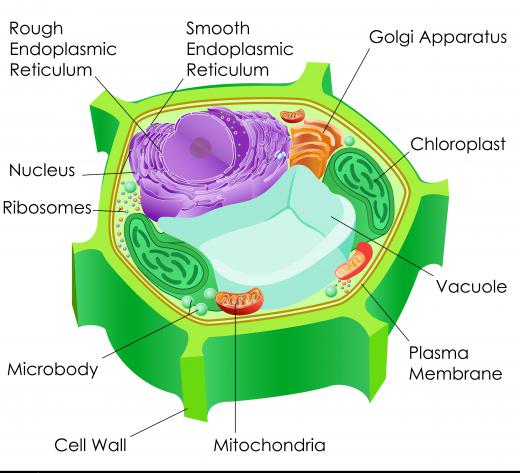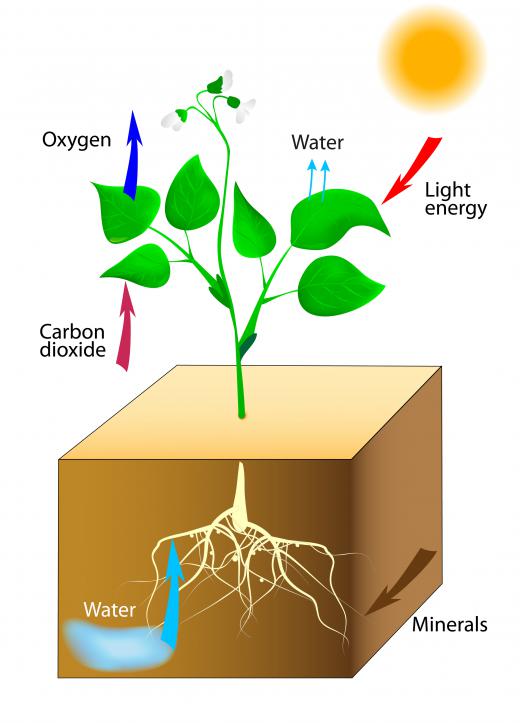What Is a Chloroplast?
A chloroplast is a type of structure, called an organelle, that is found in plants and is where photosynthesis occurs. Normally present in plant leaves, chloroplasts contain all of the components that allow the plant to convert sunlight into usable energy. The main components of chloroplasts are the membranes, chlorophyll and other pigments, grana and stroma.
Chloroplasts are one of the most important components of a plant because the entire photosynthetic process takes place in them. Each cell in a plant leaf can have 50 of these organelles. Chloroplasts appear only in eukaryokic organisms, which are primarily non-animal.

There are three types of membranes in chloroplasts: the outer membrane, the inner membrane and the thylakoid membranes. The outer membrane surrounds the chloroplast and allows molecules to move into and out of the organelle without discretion. The inner membrane is located underneath the outer and is more discriminatory about what it allows in and out of the chloroplast. The thylakoid membranes lie inside the inner membrane and are arranged in stacks that are connected together by stromal lamellae. These lamellae serve as a framework or skeleton for each chloroplast.

Chlorophyll is a green pigment that gathers the sunlight needed for photosynthesis. Located in the thylakoid membranes, chlorophyll is what causes the green coloration of leaves. Other pigments, such as carotenoids, which make carrots orange, are also found in the thylakoid membranes.
Usually, these other pigments are found in much smaller quantities than chlorophyll. Each pigment absorbs different wavelengths of light. For example, chlorophyll absorbs every wavelength but green, which is why the pigment appears green to the eye.

The grana are stacks of thylakoid membranes. Each granum stores the sunlight obtained by the chlorophyll and obtains water (Hsub2O) and carbon dioxide (CO2) from other parts of the leaves to form a type of sugar (C6H12O6) that the plant uses for food. This is the light-dependent process of photosynthesis. Sugar that is not immediately used by the plant is converted into adenosine triphosphate (ATP) and is stored for later use. This process also occurs in the grana.

The stroma is a gel-like substance that surrounds the thylakoid membranes in each chloroplast. Enzymes in the stroma take the ATP and convert it back into sugars that are then used by the plants. This process is called a dark reaction because, unlike the light-dependent reactions, it does not rely on sunlight to complete. The conversion of ATP to sugar is known as the Calvin cycle.
AS FEATURED ON:
AS FEATURED ON:














Discussion Comments
Does anyone know who a chloroplast grana actually turn sunlight into energy? I have never really understood this, and most explanations don't go into detail on the subject.
I know that sun is just light energy, but then how does a cell turn that into chemical energy or whatever it needs to make sugars?
Obviously, it would have something to do with the chloroplast, since that is where sugars are made. Does the sun activate some sort of proteins in the cell and they start to make sugar?
@jcraig - As far as I know, it really just depends on the plant. If you think about it, when a plant has just germinated, it might only have a couple of leaves, but compared to the size of the plant, those leaves might create a lot of energy. As a plant gets larger, it can make more leaves and create more energy.
At the same time, I'm sure it takes a lot of energy for a plant to actually create leaves, so I'm sure there is a very delicate balance between number of leaves, chloroplasts in the leaves, and size of the plant.
@Emilski - Good question about the change in leaf color. I read something about this a while ago. It is actually the opposite of what you mentioned. Instead of the choloroplasts getting overwhelmed, they actually start to die, and other molecules in the cell are more prevalent. The other molecules reflect red or yellow, or other colors of light. There is a different molecule for each color.
I was wondering about chloroplast development. Depending on the size of the plant, do the leaves have different numbers of chloroplasts? If you just had a small plant, it would need a lot of sunlight to grow, so wouldn't it make more chloroplasts and then have fewer as it go older?
I knew plant cells had chloroplast, but I guess I never really put two and two together about why plant leaves were green.
I guess that begs the question about why leaves turn different colors in the fall. Do the leaves get overwhelmed by some other organelle in the cells that has a different color?
How many grana does a chloroplast usually have? Is there just one big one or a lot of smaller ones?
Post your comments